|
|
Dr. Aureliano
Urrutia Founded This Institution 1921
San
Antonio is a fabulous destination. You should really go, at some
point. The place is extraordinarily pretty at Christmas, with colored
lights strung in the live oak trees lining the Riverwalk, in the relaxed
semi-Colonial air. If you're after a hotel, I'd recommend the Plaza
San Antonio, with great service and peacocks strutting around on its
croquet lawns. As a casual tourist you'll be dazzled by this romantic
atmosphere - and the history, and the music, the food, my God. It's
an easy city to love.
Ridiculously easy. |
| Handpainted tile
fountain at the former estate's main gate. |
As
a tourist, though, you're going to get the (correct) sense of missing
something important. The San Antonio
of the Mercado and the Cathedral buzzes with the street energy of
a foreign capital. This is a city of badly-kept secrets and in some
ways it's a puzzling, fractured place. You'll pick up vibes all over
the place, especially if you're sensitive to architectural remnants
and half-erased shapes.... as a casual tourist, sadly, you're going
to miss the best part. Unless you have somebody to talk to.
San Antonio really needs to be told,
not just shown. (Is this going to be on-topic? Yup. Admittedly it's
going to be a long story, but it's going to wrap around and all make
sense. This IS a travel piece. I swear.)
So
if you and I were down there for Christmas at the same time, I'd kidnap
you and drive you up Broadway from downtown, one of my favorite stretches
of road. We'd park on the small asphalt triangle of Earl
Able's parking lot at Broadway and Hildebrand, north of downtown,
and look west across this frantic intersection. (Earl
Able's is a tiny, rounded Art Moderne diner and landmark, with
corny slogans on the walls, and pie. You want some pie?)
Across the street is an early 60's-style office building on the corner
property. All back behind it, stretching out to the southwest, see,
all the way back west to 281, and all south along Broadway, is the
gorgeous live-oak-and-stone-bridge wonderland of Brackenridge Park.
All that dark forest is the big urban park, with the zoo, the mini
railroad, all those cool things.
If
you look behind the rear parking lot of that office building, though,
there's a small fenced area that looks like a neglected, overgrown
private cemetery, except instead of headstones, it's a collection
of statues and architectural fragments. Mysterious. And off-limits
to the public. And this stretch of Hildebrand here, between Broadway
and 281, it's like a curvy racetrack, and it smells like rhino farts
and monkey chow from the zoo just over the back fence. |
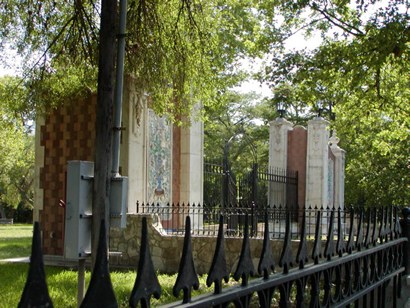 |
| A view of the
entire gate. |
And
there used to be two ornate, grand archways on the north edge of this
property, by the roadside, leading nowhere, covered with colorful
Mexican tilework in a Spanish colonial vernacular, like carriage archways.
With a beautiful hand-painted image of the Virgin. Vandalized. All
this fragmentary evidence was driving me nuts, I got really curious,
so I parked and walked over one day, looking for an explanation, taking
my life in my hands walking along Hildebrand, and on top of the larger
arch there was an oxidized bronze plaque.
It said DOCTOR URRUTIA.
(Let's go inside Earl
Able's. You want some pie? Actually that meringue looks a little
rubbery, go for the pecan, I think.) |
| Tile peacocks,
frogs, and the Virgin of Guadalupe |
| Close up view
of the tile peacocks |
I
got
really intrigued with Dr. Urrutia. Mom and Dad lived in this neighborhood
in the mid 50's, and I asked Mom, and she said, "Oh yeah. He had a
huge mansion there, like a palace, they tore it down where he sold
the property to USAA. You could see him coming out in the mornings,
and he always wore an opera cape. He was old by the time, in his 70's
or 80's, but he used to come out and feed his peacocks running around.
In this cape." My uncle Ben chimed in about how that old doctor had
about 10 kids, and all of them were doctors, and about half of them
had horns. Ben is old and wise and completely trustworthy and also
full of it.
So I turned to the web. . . and you're not going to believe me.
The
grand property across the street was called Miraflores, and Dr. Urrutia
was Dr. Aureliano Urrutia, who died in his sleep in 1975, at the age
of 103. After having five wives, the fifth about 40 years younger
than he, 18 children, after practicing medicine for 81 years, inventing
medical procedures still used today, being one of the first surgeons
to separate Siamese twins - but that's not the interesting part.
Dr. Urrutia was a Mexican political exile when he arrived in
San Antonio in 1915, in his early forties.
He'd been born into full-blood Indian poverty in 1872 in Xochimilco,
the town of the floating gardens, a little south of Mexico City. Urrutia
rocketed out of the floating gardens like an underwater surface-to-air
missile. By 1895 Urrutia had graduated at the top of his medical school
class, sponsored by the president of Mexico himself, Porfirio Diaz.
Diaz named him his personal physician at the age of 22.
Presidente Diaz got in trouble in 1910 and stepped down with his head
still attached, his fortune intact - he'd been ruling for 30, 35 years
if I remember right - but after Diaz, from 1910 to 1920, Mexico
wasn't ruled as much as it was repeatedly raped. This was the age
of bloody insurrections, clumsy intrigue, peasant revolutions, open
warfare, dust and blood. Orozco, Villa, Zapata. More than once, the
course of Mexico's history swiveled back and forth on the murderous
impulses of drunk corporals and illiterate machine-gunners.
Diaz was replaced by a vegetarian idealist Francisco Madero in 1910,
but Madero had unleashed forces that he couldn't control. He lasted
about thirteen months. Madero's brother/advisor was brutally murdered,
a messy killing with a sword thrust into his good eye for a first
inning. Then Madero himself was openly betrayed and shot in the neck.
This made way for possibly the worst president Mexico ever had, which
is really saying something: a drunken military gangster named Victoriano
Huerta.
Well, guess who had operated on Huerta's eyes. Guess who'd been implicated
in the murder of Madero. Guess who was made Huerta's close advisor
and trusted Minister of Government in 1912, and was supposedly more
or less acting president. Guess who! None other than the guy who lived
across the street from Earl
Able's. Our friend, Doctor Urrutia. |
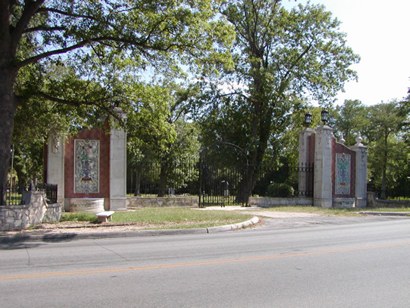 |
| View from across
the street. |
| In
the full sunshine of 1913 Dr. Urrutia was known for trying to pass
a raft of reform legislation under Huerta, things like a blue law,
streetcar reform, and ordering the closure of the pulquerias.
|
|
(Pulque
is a rich sort of fermented beer made from agave, like tequila and
mescal, but brewed instead of distilled. Pulque has a long
long history in Mexico.... the Olmecs and Zapotec civilizations
made and drank pulque -- it was the liquor of choice for Aztecs,
for whom public drunkenness was an offense punishable by death,
but who had a five-day pulque frenzy at the end of the year...
the Nahuatl had a goddess named Mayaheul with 400 breasts, each
of which oozed pulque. To which I say, you go girl.
Hacienda pulquerias grew up as peasant-class breweries and
underground drinking clubs. my understanding is that this was a
peasant tradition, wrapped around native traditions and legends
(probably ethnic and class dynamics at work). with names like the
Plumed Serpent or whatever, strong centuries-old local identities,
like English pubs. and I get the sense that pulque was as deeply
rooted and necessary to make Mexican peasant life bearable, as vodka
is/was in Russia.
The other thing about pulque is that it's never been successfully
bottled, and it's extra perishable, and sort of a secret.
When Dr. Urrutia tried to close the pulquerias in 1912. I
guess he did so ostensibly on public health grounds, because during
the Diaz presidency more and more peasants were getting toxemia
from sloppy brewing practices. Since this was the revolution, though,
and since pulquerias were logical birthplaces and hiding
places for a Peasant Revolutionary Network, and good places to hide
ammunition and stuff, I'm supposing that Dr. U had more on his mind
than wholesome beer. That's just my guess.)
|
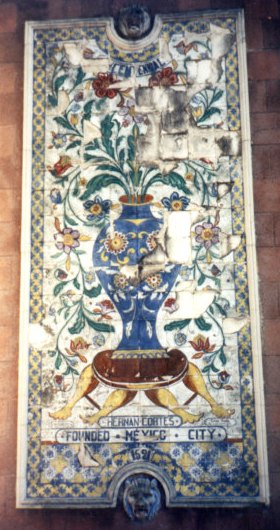 |
But
after dark, Urrutia was also accused of a medical assassination -
a federal senator from Chiapas who publicly spoke against Huerta,
Belisario Dominguez, was arrested as an enemy of the government, in
the Jardin Hotel, on October 7, 1913, then taken to a cemetery, where
dark persistent rumor has it that Dr. Urrutia cut out his tongue.
Without anesthetic.
Huerta threw eighty congressmen into prison at one point. Urrutia
himself issued an ill-advised ultimatum to the US government, wanting
official recognition, and Woodrow Wilson responded with battleships
to Veracruz. In the late summer of 1914, as this government fell apart,
a lot of the Huertistas and the well-to-do and ex-governors and henchmen
drained out through Veracruz. Dr. Urrutia was arrested there by General
Frederick Funston and was allowed to exile himself to the US:
by ship from Veracruz to New Orleans, train from New Orleans to San
Antonio, and two rail cars of treasure smuggled across the border
later, to finance his new American life and humanitarian career.
All of which brings us back here to Earl
Able's parking lot. |
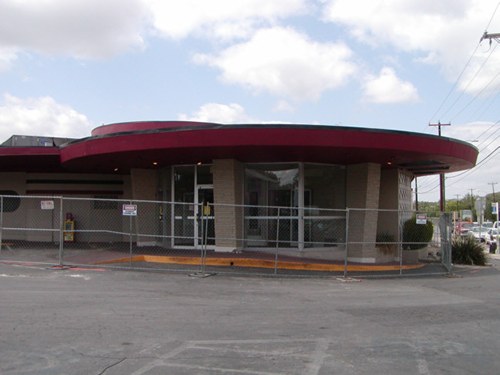 |
| It
doesn't matter, really, whether Urrutia was an innocent exile or a
war criminal or something in between. (Oh, I should have told you,
somewhere in here, that as a full-blood Indian, with charisma, Urrutia
would have provoked an extra edge of fear and respect from some of
his countrymen. It's wrong to say that all Mexicans are superstitious,
of course, but it's right to say many Mexicans would still go a long
way out of their way to avoid the kind of personal bad Indian medicine
that Dr. U would have dripped with.) It doesn't matter. The two gates
on Hildebrand have been taken apart and carted off to SAMA. All that
remains of his medical empire is a strange, off-limits garden behind
that early 60's-style office building across the street. |
| Tiled bench on
the grounds of the former estate. |
Dr.
Urrutia's story is a great example of San
Antonio's untold backstory. I had to dig for this one, but you
won't have to go this far to find out why there's deer kept in the
Quadrangle at Fort Sam Houston
(for Geronimo's lunch, when he was captive there in 1886), or who
Clara
Driscoll wanted to piss on and why, or the uncomfortable medical
news about the defenders of the Alamo,
or two hundred other San Antonio stories.
Of course every city, even Cincinnati, has a backstory, but the ones
around here seem more sensual, more dramatic, human, tied to the landscape.
You'll enjoy this city so much more if you have somebody weave it
for you.
For another thing, the career of Dr. Urrutia also speaks volumes about
the relationship of San Antonio to
Mexico, and
San Antonio's curious double political
nature, and what happens when people weave their complicated histories
back and forth across this semi-tropical shadowland frontier. Stand
in front of the Alamo, and you're standing
closer to Mexico City than you may realize. A crime there isn't the
same crime here. Some things are talked about, some aren't. |
|
|
Major
General Frederick Funston ›
Was he killed
by Dr. Urrutia's application of the"evil eye"?
Funston as a Captain in the 20th Kansas.
Photo courtesy Kansas State Historical Society
|
| |
And
there's one more fatality to insert. Three years after Urrutia established
himself here, in 1917, he crossed paths with that General
Frederick Funston in the lobby of the St. Anthony Hotel. You know,
the American who ran him down. As the story goes, Urrutia froze, stood
his ground - you can practically see him clutching the panels of his
black cape - and shot Funston
el mal de ojo, the evil eye. It's a matter of public record
that Funston
died of a heart attack on that spot.
If San Antonio is half-Mexican, and
it is, and always balanced on the edge of the spiritual border, then
you do well to understand that Mexico
has its own unseen sources of emotional power, its own rules, blood
and dust, its own thing. You're allowed to be a tourist and smile
at bad medicine and el mal de ojo and the Day
of the Dead if you want to. But the moment you're willing to admit
that such a thing is possible, is the same moment San
Antonio will ease into focus and open like a flower.
(How was your pie?) |
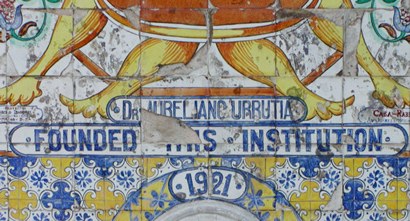 |
Postscript:
in the summer of 2004 I received a message that Dr. Aureliano Urrutia
of San Antonio wanted to talk to me.
Luckily the man on the other end of the phone was Dr. Aurreliano 'Bud'
Urrutia, the 70-year-old grandson of the original Dr. U, and he couldn't
have been more gracious. Bud is, as I understand, the sitting patriarch
of a whole dynasty of medical Urrutias in SAT, three generations of
large families, and is himself still practicing out of the Nix Bldg
on Navarro Street downtown, where my grandmother was in the first
nursing class around 1900. Some of the fun of talking to Bud was that
his gently authoritative Texan verbal cadence reminds me of my own
father.
Bud knew his grandfather. He confirmed that everything you read above
was accurate, and added some other details. Was he upset that I refered
to his grandfather in less-than-flattering ways? Not at all. He said
that was old family business, and brushed it aside.
He said some of the dates in my piece were about a year late, and
said that Dr. Urrutia entered the US through Galveston,
not New Orleans.
Of the two former Urrutia properties on Broadway, Miraflores is the
more southern property, where the car dealership is/was. The property
across from Earl
Able's had no mansion, it had one structure in the middle, something
like a windmill. Interestingly there is no clear title to Miraflores.
Dr. Urrutia did not buy the property, he ‘acquired’ it in some unknown
way. In the context of contemporary Texas land law, he said, this
is not necessarily as sinister as it may sound.
Family lore confirms the Funston
mal de ojo. Bud had spoken to his father about it, and his
father was there in the lobby of the St. Anthony at the time. "Oh,
this son-of-a-bitch again." (I’d forgotten about the south Texas use
of 'son-of-a-bitch', not as a heated insult, but as a simple act of
categorization which is many times worse.) And yes, Funston
died on the spot.
Bud’s father would not discuss the murder of Senator Dominguez, saying
only that it was a rough time in the history of Mexico.
Did Dr. U invent medical procedures? Yes. Maybe not the first to separate
Siamese twins, but certainly an early procedure, in 1917. Also developed
a method of prostate removal through the perineum. And Dr. U was responsible
for bringing the San Antonio cult craftsman
Dionicio Rodríguez to the city to work on one of his houses.
And Bud described Madero as an early hippie. He’d been to school in
Berkeley, which can change a fella’s outlook, and was a old-school
spiritualist who received governmental instructions on letters from
his dead brother Raul, who’d died in a fire at the age of four.
© Walt Lockley. All rights reserved.
September 29, 2007
Published with permission
Texan Walt Lockley (San Augustine, 1963) and his collaborator Einar
Einarsson Kvaran are compiling a book on architectural sculpture in
America, to be investigated in a future issue of Texas Escapes. They're
an unexpected wealth of integrated sculpture in the state, from sculptors
including Pompeo
Coppini, Raoul Josset,
Herring Coe, and whoever did all that work for Lang and Witchell in
Dallas. If these names mean anything to you, or even if they don't,
please pay them a visit at www.archsculptbooks.com
|
|
|
